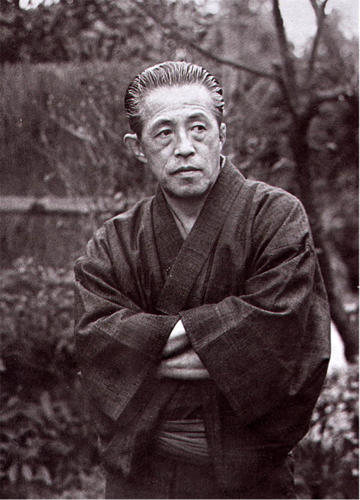
I cannot claim to have discovered or rediscovered the fiction of Inoue Yasushi (1907-1991), since someone(s) had to translate it from Japanese for me to read. And it was the New York Review Classics edition of Tun Huang that attracted my attention to his work. Inoue won the Akutagawa Prize (the most prestigious Japanese literary prize) in 1950 for the short novels Ryoju and Togyu (The Hunting Gun and The Bullfight in English, though only the former book has been translated into English, alas).
I realized that I’ve seen two Japanese movies based on Inoue novels, The Samurai Banner of Furin Kazan (filmed as “Samurai Banner” 1969) and Blue Wolf: A Novel of the Life of Chinggis Khan (filmed in 2007 in Japanese as “The Blue Wolf: To the Ends of the Earth and Sea”) and that there are sixteen more Japanese movies based on Inoue novels, including “Death of a Tea Master” starring Mifune Toshio (1989) and “The Warrior and the Wolf” (2009), that I have not seen. Most of Inoue’s fiction was set in the Chinese past, including a novel about Confucius, as well as the one about Chinggis (Genghis) Khan, and Tun Huang (which provides an explanation for the trove of Buddhist, Nestorian, and Daoist scrolls sealed into one of the “Buddhist caves” near Tun Huang.
The Hunting Gun (Ryōjū) is a contemporary (as of 1950) tale that has very little to do with the titular (Churchill) rifle, though it occasions the owner of the gun, a businessman named Misugi Yosuke contacts a poet who wrote about seeing the hunter along a river at the foot of Mount Amagi. Josuke sends the poet three lengthy letters from three women, Shoko, the mousy daughter of his recently deceased mistress, who leanred of the course of the affair from her mother’s diary; Midori, his much-neglected wife; and one from his mistress, Saiké,written on the day she killed herself. The multiple perspectives are more cumulative than conflicting (in contrast to Kurosawa’s “Rashômon,” also released in 1950). The daughter knew least about the love triangle, the wife was slow to learn of it, and the mistress knew she was betraying her friend by having an affair with her friend’s husband, but writes that she was happy. And the recipient of the three letters cannot have learned much from them, though he wants the poet to understand his loneliness and the pain he caused to the women.
Loneliness is also central to the novella The Counterfeiter and two short stories translated and introduced by Leon Picon in 1965. The narrator of The Counterfeiter was commissioned by the heirs of Onuki Keugaki to write a biography of the revered painter, but became more interested in Hara Hosen, an early friend of the painter’s who counterfeited works because they sold better than paintings signed with his own name. “The Full Moon” shows the fall of a large business’s president (Kagebayashi) as evidenced in the company’s annual moon-viewing parties (a tradition he initiated). Both of these are sharp stories of failure and resentment.
The narrator of “Obasute” is obsessed with the abandoned tradition of old people going up a mountain to die rather than burden their families with taking care of them (also the subject of Kobayashi’s Imamura’s films “The Ballad of Nariyama”). He comes to believe that his own mother is tired of him and that there was more to leaving than consideration for the next generation scratching out a living.
On the basis of the four volumes I have read, Inoue was a modern (and in his fiction set in the Japan of his time, modernist) writer, as good as and less obsessive than Kawabata Yasunari (1899-1972), who became the first Japanese to win the Nobel Prize for literature (in 1968).
©2016, Stephen O. Murray